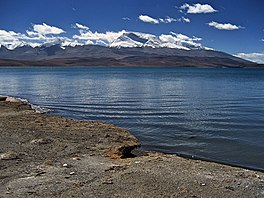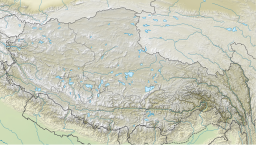Lake Rakshastal
| Lake Rakshastal | |
|---|---|
 View South from Rakshas Tal Lake (2006) | |
| Location | Tibet Autonomous Region, |
| Coordinates | 30°39′N81°15′E/ 30.65°N 81.25°E |
| Lagngar Co | |||||||
|---|---|---|---|---|---|---|---|
| Chinese name | |||||||
| Traditional Chinese | Kéo ngẩng sai | ||||||
| Simplified Chinese | Kéo ngẩng sai | ||||||
| |||||||
| Alternative Chinese name | |||||||
| Traditional Chinese | Lan ca sai | ||||||
| Simplified Chinese | Lan ca sai | ||||||
| |||||||
| Tibetan name | |||||||
| Tibetan | ལག་ངར་མཚོ | ||||||
| |||||||
Lake Rakshastal(Tibetan:ལག་ངར་མཚོ;Sanskrit:राक्षसताल,romanized:Rākṣasatāla;Chinese:Kéo ngẩng sai) is a saltwaterlakeinTibet Autonomous Region,China,lying just west ofLake Manasarovarand south ofMount Kailash.[1][2]TheSutlej River(also known by the Tibetan nameLangqen Zangboin this area) originates at Rakshastal's northwestern tip.
Etymology
[edit]The name of the lake literally means "lake of therakshasa"in Sanskrit. It is also known asRavan Tal,as it is considered to be the site of the penance performed byRavana,the rakshasa king ofLanka.[3]
InBuddhism,Lake Manasarovar, which is round like the sun, and Rakshastal, shaped as acrescent,are respectively regarded as "brightness" and "darkness". Rakshastal is a saline lake. There is a short river namedGanga Chhu,which connects Lake Manasarovar with Rakshastal, believed to be created byrishisto add pure water from Manasarovar.
There are four islands in Rakshastal, named Topserma (Dose), Dola (the two biggest), Lachato (Nadzhado), and Dosharba.[4]The islands are used by local people as winter pastures for their yaks.
In the Tibetan language, the lake is known as Lagngar Cho or Lhanag Tso, which means "the dark lake of poison".
Religious significance
[edit]According toHindu scriptures,Rakshastal was created by Ravana for the express purpose of garnering superpowers through acts ofdevotionandmeditationto the god,Shiva,who resided on Mount Kailash. It was upon the banks of a special island in this lake that he would make a daily offering with one of his ten heads as a sacrifice to please Shiva. Finally, on the tenth day, Shiva was moved enough by his devotion to grant Ravana his wish to obtain superpowers.
As there are no plants or wildlife around the lake, its lifeless surroundings caused the Tibetans to refer it as "the Ghost Lake". Visitors who approach the lake must be respectful to avoid inauspicious mishaps.[5]
Geography
[edit]Rakshastal covers a total area of 250 square kilometres (97 sq mi), at an altitude of 4,575 metres (15,010 ft). Though absent of nearbygrasslands,the white cobbles, the hills and the island colored with dark red, and the deep blue lake water present another distinctive picture absent from many of the places more frequented by visitors. In 2004, Lake Manasarovar and Rakshastal were designated as a singleRamsar Wetlandcomplex, under the name 'Mapangyong Cuo'.[6]
Access
[edit]Lake Rakshastal lies right next toLake Manasarovar,and is an integral part of the Kailash-Manasarovar pilgrimage.
Climate
[edit]| Climate data for Lake Rakshastal | |||||||||||||
|---|---|---|---|---|---|---|---|---|---|---|---|---|---|
| Month | Jan | Feb | Mar | Apr | May | Jun | Jul | Aug | Sep | Oct | Nov | Dec | Year |
| Mean daily maximum °C (°F) | −2.7 (27.1) |
−1.5 (29.3) |
1.3 (34.3) |
6.7 (44.1) |
10.5 (50.9) |
13.7 (56.7) |
13.6 (56.5) |
13.1 (55.6) |
11.1 (52.0) |
6.6 (43.9) |
1.5 (34.7) |
−0.8 (30.6) |
6.1 (43.0) |
| Daily mean °C (°F) | −8.2 (17.2) |
−6.9 (19.6) |
−3.7 (25.3) |
0.3 (32.5) |
3.5 (38.3) |
7.3 (45.1) |
8.5 (47.3) |
8.2 (46.8) |
5.6 (42.1) |
0.2 (32.4) |
−4.5 (23.9) |
−6.6 (20.1) |
0.3 (32.6) |
| Mean daily minimum °C (°F) | −13.6 (7.5) |
−12.3 (9.9) |
−8.6 (16.5) |
−6.0 (21.2) |
−3.4 (25.9) |
1.0 (33.8) |
3.4 (38.1) |
3.3 (37.9) |
0.1 (32.2) |
−6.2 (20.8) |
−10.4 (13.3) |
−12.4 (9.7) |
−5.4 (22.2) |
| Averageprecipitationmm (inches) | 58 (2.3) |
39 (1.5) |
58 (2.3) |
34 (1.3) |
29 (1.1) |
46 (1.8) |
142 (5.6) |
152 (6.0) |
76 (3.0) |
32 (1.3) |
8 (0.3) |
20 (0.8) |
694 (27.3) |
| Source:Climate-Data.org | |||||||||||||
See also
[edit]References
[edit]- ^Taruna Vijaya (2001).Kailash Manasarovar, an odyssey in Tibet.Ritwik Prakashan. p. 58.ISBN9788190057127.Retrieved2012-07-24.
- ^Lhanag Tso(The Ghost Lake), Ngari Tourist Sights,Tibet Travel.Info
- ^Pradeep Chamaria (1996).Kailash Manasarovar on the Rugged Road to Revelation.Abhinav Publications. p. 67.ISBN978-81-7017-336-6.Retrieved2012-07-24.
- ^"Kailash 2010 | Kailash".Archived fromthe originalon 2010-11-05.Retrieved2010-10-11.
- ^Lhanag Tso(The Ghost Lake), Ngari Tourist Sights,Tibet Travel.Info
- ^Bubriski, Kevin; Pandey, Abhimanyu (2018).Kailash Yatra: a Long Walk to Mt Kailash through Humla.New Delhi: Penguin Random House. p. 135.

